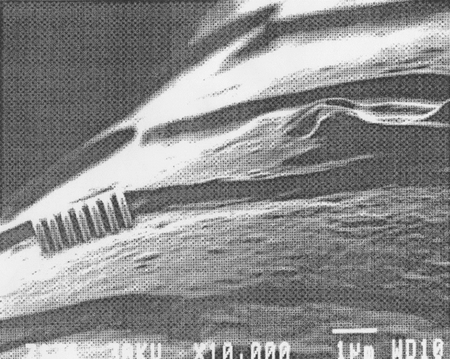On Monday, I said that today (Wednesday), I would report on my progress in my article marketing experiment. Actually, I am making some really good progress with Article Post Robot, and I have been working with Garry Conn on a new Adsense-optimized theme for WordPress. I'm waiting on some articles to be approved in the article directories, so I decided to move that post on article marketing to Friday.
While I was making that decision, I got back to thinking how weird it was to be off line over the weekend due to the storms and the kidnapping, and how cool it is that you can make money online from your home. What really makes this possible?
Answer: Semiconductors (and the electrons they manage).
Then I wondered, how many Internet Marketing geeks (or general web surfers) really understand the technology that allows them to read my blog? I mean, we all hear the marketing buzz about Intel and AMD microprocessors, and quad core technology and all that. But what does it mean? How can you put it into human terms?
How Small is Small?
Well, one way to get at this question is to consider how small the guts of a computer chip are. Here is a picture I pulled off of my hard drive out of a presentation that I made in 2000.

The image is from a friend of mine at Siemens in 1997. It shows a human hair magnified 1000 times with some “stuff” on it. The black box marks the “stuff.” The “stuff” is the size of several transistors (transistors are the building blocks of computer chips). You can think about a transistor as a way to store a one or a zero. If the transistor is off, it is a zero; if it is on, it is a one. If you want to store that result for any lenght of time, you need to get several transistors together to make a “memory cell.” The transistors work together to help each other remember if they are storing a one or a zero. Once you have ones and zeros, you can hook transistors together to count, add, subtract, multiply, etc.
If you zoom in on the picture above you see this:

The above image is the same hair magnified 10,000 times. On the hair, you can see that the “stuff” is seven things that are the same size as a transistor was in 1997. Since 1997, the semiconductor industry has been able to shrink the size of stuff like this about a factor of 5 or so (depends on how you measure it). So, things are much smaller today.
Putting it in Perspective
![]()
The above picture is from another presentation that I gave in 2000 (and I cannot remember the origonal source for the drawing). This drawing shows that same human hair on the right and a bacteria on the left. On the far left, you can see the size of a the same set of typical transistor lines from above. Of course, the message is that semiconductor circuits are much smaller than bacteria. In this picture the circuit patterns are depcited about the size they were in 2000. They are about half that size today (or smaller in many cases), and getting smaller as we speak.
So, what does it look like inside the chip.
The final picture I'll leave you with is a tear-down of an integrated circuit where you can see these small features hooked together to form circuits.

In this picture, I am only showing the wires that connect transistors together. A single wire is the size of one of the lines on the hairs above. So, when you go to Best Buy to grab that next computer — now you know what's inside the box. Tiny structures that control the flow of electrons. It is the meaning of life in modern times.
As a semiconductor engineer (my day job), I am in the business of making these things. Often, I am asked — “Yo, Mark, How do you make stuff that small.” Every time the answer is the same — very carefully.





wow Mark, you smart people amaze me 🙂 Who would of thought that semiconductors are what pay my bills.
Very good post…a little over my head, but good.
Glad you liked it — hope it wasn’t too nerdy. I was thinking maybe pictures would help. Don’t feel bad — everyone that I work with is a hell of a lot smarter than me. LOL
Mark, there’s nothing quite like a single human hair to put it all in perspective is there? Thanks for the microscopic tour of your day job. I love this kind of stuff!
Ahhh… blogging and science combined…
What can be a better read?
Nice photos!
Cheers,
Alex.
@Alex — Science is really cool. keeps me excited about my day job.
@Jason — You are welcome. I get to talk about this every day from 9-5, so I kind of take it for granted. Glad you enjoyed it.
Regards,
Mark
All I can say is wow! I have not yet seen an image such as this and it really helps to put some perspective to the world of electronics and how sophisticated our computer technology has become. Makes you wonder how small the nano-chips actually can be..
Very interesting post, Mark. Keep it coming.
regards
Marion